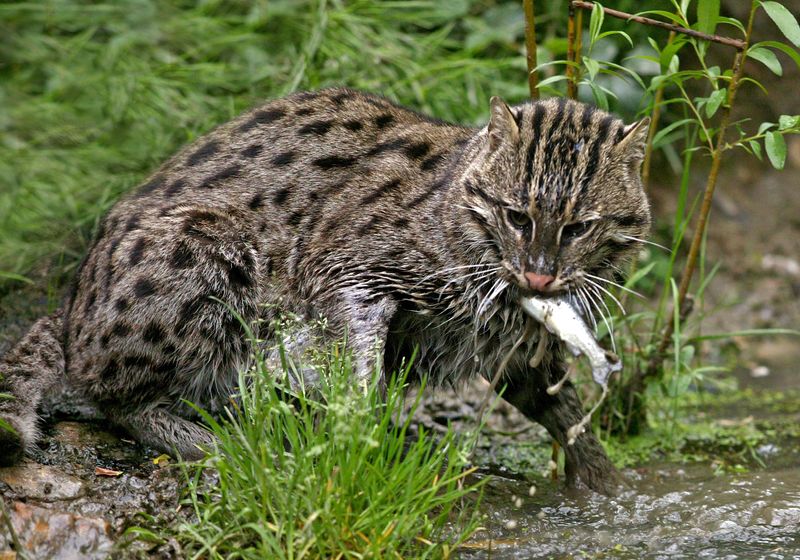
Genome Spotlight: Fishing cat (Prionailurus viverrinus)
ABOVE: A fishing cat living up to its name. © ISTOCK.COM, SLOWMOTIONGLI
Anyone who thinks cats hate water has clearly never met a fishing cat (Prionailurus viverrinus). These midsized (5–17 kg) South and Southeast Asian cats seem as at home in water as they are on land, capable of swimming long distances both at and below the surface. In captivity, they start playing in water as young as two months old, and when fully grown, about three-quarters of their diet comes from fish.
Unfortunately for these unique cats, the wetlands they rely on are disappearing, and many of those that remain are polluted or claimed by people, who see the cats as competitors for caught and aquacultured fishes. In one study in Thailand, for instance, 84 percent of fishing cats that were outfitted and tracked with radio collars ended up getting killed.
Because of the myriad threats facing the felines, captive breeding programs have been established around the world. And that’s what allowed scientists to notice at least one threat to the animals in captivity: cancer.
Unlike their domesticated cousins, captive fishing cats are prone to transitional cell carcinoma (TCC), a lower-urinary tract cancer. Researchers suspected that their vulnerability to the disease may have a genetic basis, as breeding populations are founded with relatively few animals and, therefore, can have low genetic diversity. But to find disease-causing genes, researchers need genomic tools—tools that now are available for fishing cats, thanks to a high-quality reference genome published as a bioRxiv preprint November 18.
The genome was assembled from PacBio HiFi reads with chromosomal arrangements determined using Hi-C chromatin capture. In all, 96.3 percent of the 2.46 Gb assembled genome was assigned to chromosomes, and a BUSCO analysis estimated the sequence is 93.5 percent complete.
Armed with a robust genome, the researchers began the search for candidate TCC-related genes in a cohort of 11 fishing cats, 5 of which had TCC. They first searched for the cat’s version of eight human genes associated with bladder cancer, observing missense variants of four of those genes in the TCC group—BRCA1, BRCA2, CHEK2, and ATM. But BRCA2 stood out, as the team found two missense variants of it in all of the TCC-afflicted animals. However, the variants were also present in half of the control cats, so the team was unable to conclude the variants are responsible for the animals’ heightened TCC risk. Additional genomic sampling, which is becoming increasingly affordable, “will help clarify causative risk variants,” the authors conclude.
The study serves as a template for using the vast knowledge accumulated for human diseases to tease apart the etiology of other animals’ conditions, the authors say, adding that findings from such comparisons could guide mating decisions and warn human caretakers of animals at particularly high risk of future disease.
And such discoveries aren’t a one-way street: Findings from animals can shed light on mysteries in human health. Other researchers have noted that feline TCC shares key similarities with the human cancer, so further research on TCC in fishing cats could, one day, lead to a deeper understanding of this cancer in people, which is responsible for around 95 percent of all bladder cancers and kills more than 15,000 people in the US each year.
Runners Up:
Northern armyworm (Mythimna separata)



Genome Spotlight is a monthly column for The Scientist’s Genetics & Genomics newsletter that highlights recently published genome sequences and the mysteries of life they may reveal.





































































